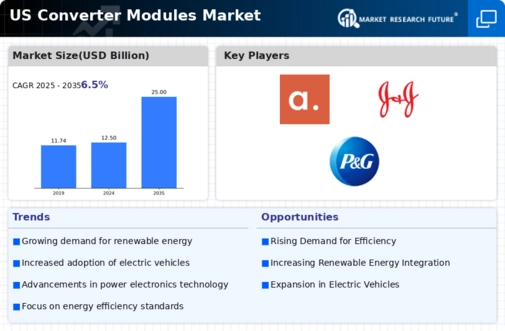Growing Adoption of Smart Grid Technologies
The growing adoption of smart grid technologies in the US is a significant driver for the converter modules market. Smart grids enhance the efficiency and reliability of electricity distribution, necessitating advanced power conversion solutions. Converter modules are vital for managing the flow of electricity and integrating distributed energy resources into the grid. The US government has invested heavily in smart grid initiatives, with funding exceeding $4 billion in recent years. This investment is expected to accelerate the deployment of smart grid technologies, thereby increasing the demand for converter modules. The converter modules market is poised for growth as utilities and energy providers seek to modernize their infrastructure and improve grid resilience.
Expansion of Electric Vehicle Infrastructure
The rapid expansion of electric vehicle (EV) infrastructure in the US is a key driver for the converter modules market. As more consumers adopt EVs, the demand for efficient charging solutions increases. Converter modules are integral to the development of EV charging stations, facilitating the conversion of AC to DC power. The US government has set ambitious targets for EV adoption, aiming for 50% of all new vehicle sales to be electric by 2030. This initiative is expected to create a substantial market for converter modules, with estimates suggesting a potential increase in market size by over $5 billion by 2027. The converter modules market is thus likely to experience robust growth as it supports the electrification of transportation.
Rising Demand for Renewable Energy Solutions
The increasing emphasis on renewable energy sources in the US is driving the converter modules market. As the nation transitions towards sustainable energy, the need for efficient power conversion systems becomes paramount. Converter modules play a crucial role in integrating renewable energy sources, such as solar and wind, into the existing grid. According to recent data, the renewable energy sector is projected to grow at a CAGR of approximately 10% over the next five years. This growth is likely to enhance the demand for converter modules, as they are essential for optimizing energy conversion and ensuring grid stability. The converter modules market is thus positioned to benefit significantly from this shift towards cleaner energy solutions.
Technological Innovations in Power Electronics
Technological innovations in power electronics are reshaping the converter modules market. Advancements in semiconductor materials, such as silicon carbide (SiC) and gallium nitride (GaN), are enabling the development of more efficient and compact converter modules. These innovations allow for higher power densities and improved thermal management, which are critical for modern applications. The market for power electronics is projected to grow at a CAGR of around 8% through 2028, indicating a strong demand for cutting-edge converter modules. The converter modules market is likely to benefit from these technological advancements, as manufacturers strive to meet the evolving needs of various sectors, including renewable energy and electric vehicles.
Increased Focus on Energy Efficiency in Industrial Applications
The push for energy efficiency in industrial applications is significantly impacting the converter modules market. Industries are increasingly adopting energy-efficient technologies to reduce operational costs and comply with regulatory standards. Converter modules are essential for optimizing energy use in various industrial processes, including manufacturing and automation. Recent studies indicate that energy-efficient systems can reduce energy consumption by up to 30%. This trend is likely to drive the demand for advanced converter modules, as industries seek to enhance their energy performance. The converter modules market is thus expected to see a surge in demand as companies prioritize energy efficiency and sustainability.













Leave a Comment